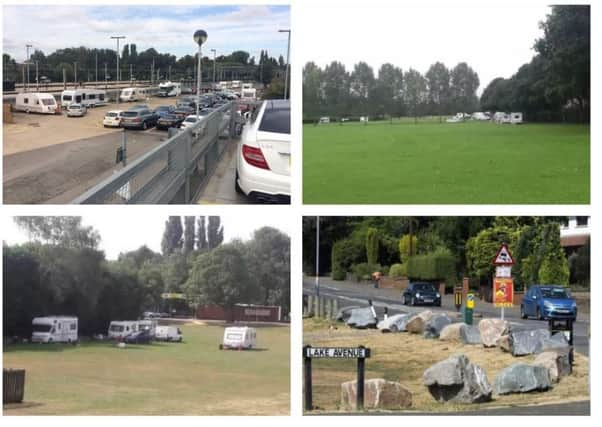Travellers visit Northamptonshire 251 times in just one year


In 2014/15 there were 145 encampments in the county; but in 2017/18 travellers visited 251 times.
The figures also show that just 46 of the 2014/15 encampments were on private land, almost tripling to 121 by 2017/18, by which time many more councils had protected their land with prohibitive fencing, bunding and height barriers.
Advertisement
Hide AdAdvertisement
Hide AdDuring 2017/18, out of a total of 251, the number of traveller encampments in Northampton was 101, followed by 43 in Corby, 30 in South Northants, 22 in Kettering, 21 in Wellingborough, 18 in Daventry and 16 in East Northamptonshire.
Also during the same year, private landowners were forced to take removal action 113 times, with the police using their eviction powers 27 times and the councils acting to remove travellers 111 times.
Travellers parked up on private land 121 times, on Northamptonshire County Council land 55 times and local authority land 75 times.
During the past four years the budget for the Northamptonshire Countywide Traveller Unit (CTU) remained static at £135,558 per year, with 2.5 full time staff.
Advertisement
Hide AdAdvertisement
Hide AdThe figures were revealed as part of a detailed Freedom of Information request by this paper to the CTU which is run as a partnership between the county councils and all the boroughs, excluding East Northamptonshire.
Communities have repeatedly told this newspaper they are concerned about mess, damage and crime when travellers arrive in town.
But Cllr Andy Mercer, chair of the executive board of the countywide traveller unit says many travellers fly under the radar and do not cause any problems.
He said: “Travellers are individuals and each do things for different reasons.
Advertisement
Hide AdAdvertisement
Hide Ad“We don’t know why the number of encampments has so much increased in Northamptonshire. There’s no over-riding driver.
“There’s been a dramatic increase of about 60 per cent in 18 months.
“Nobody has done a survey to ask them why, all we can say is there’s been a big upturn.
“The pressure on the staff at the CTU will have increased as a result but they’ve done a superb job.”
Advertisement
Hide AdAdvertisement
Hide AdCllr Mercer said that the reasons for the upturn would probably only become apparent in the future when the unit could look back with hindsight.
“You can’t make definitive statements about people’s behaviour when it is happening,” he added.
The data also showed that in 2014/15, 91 out of the 145 encampments eventually left after negotiation with the countywide traveller unit, while in 2017/18 only 69 out of 251 encampments were ended after negotiation.
Local authorities have the powers to move travellers on from their own land, but only after following a strict set of guidelines. The police also have powers under section 61 of the Criminal Justice and Public Order Act 1994 to require travellers to leave.
Advertisement
Hide AdAdvertisement
Hide AdCllr Mercer added: “The first thing is to determine whether the land is publicly or privately owned.
“If it’s public land the police will visit and site and do an inventory of who is there,” he said.
“The CTU will then help if there are issues with schooling or medical care.
“If someone turns up in a strange place at a strange time we can usually say it’s because they’ve got a medical issue.
Advertisement
Hide AdAdvertisement
Hide Ad“We’ll talk to them and ask them how long they’re planning to stay.
“Only in a small minority of places will they seek to move them on.”
Cllr Mercer said there are many examples of peaceful, low-key encampments that are not causing an issue to people in the county.
“We know of one couple where the lady was heavily pregnant and then had her baby and we are just letting them stay because there’s no reason for us to interfere with their lifestyle.
Advertisement
Hide AdAdvertisement
Hide Ad“We just make arrangements for their litter to be picked up by the local authority.”
Cllr Mercer said he has seen some threatening behaviour by members of the public towards travellers.
“It’s certainly not our job to ‘get rid’ of travellers,” he said.
“A couple of years ago I actually had to threaten someone with legal action.”
Advertisement
Hide AdAdvertisement
Hide AdHe said that there are all different types of nomadic groups in the county who all behave differently.
“There’s Romany, English, Irish, New Age and other smaller groups and you just can’t lump people together.
“As with any community there’s people that are good and people that are bad.
“There’s any number of groups that travel around from one place to another and our staff know them by their first names and we sometimes move them to more appropriate areas.
Advertisement
Hide AdAdvertisement
Hide Ad“If you’re reasonable with them then they’re reasonable with you.
“The staff are working very hard and with not extra personnel and a 60 per cent higher workload. What they’re doing is pretty incredible.
“The level of experience they have, you can’t buy.”
Cllr Mercer says he hopes that the CTU is one part of the council that is able to remain when unitary councils are established.
He said: “The process is going to split the county in two.
“My personal choice would be to retain the CTU, funded jointly by the two unitaries. I can’t see how something like the CTU would be able to be run by the smaller authorities.”
You can access all the travellers data in the Freedom of Information requests for the past four years using this link